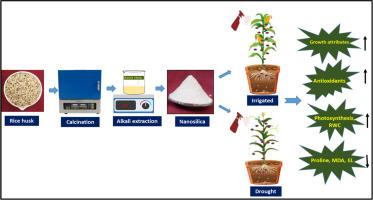叶面喷施稻壳提取的纳米二氧化硅,通过增强抗氧化防御系统缓解杂交玉米的干旱胁迫
IF 5.4
Q2 ENGINEERING, ENVIRONMENTAL
引用次数: 0
摘要
气候变化加剧了干旱的频率和强度,对全球粮食安全和农业生产力构成了重大挑战。化学合成纳米二氧化硅已成为管理干旱胁迫、提高作物生长和抗逆性的一种有前途的解决方案,但其生产涉及有害化学物质,会对土壤、植物和环境造成不利影响。因此,本研究旨在从稻壳中绿色合成和表征纳米硅颗粒,并评估其改善杂交玉米植物生长、发育和胁迫缓解的潜力。从稻壳中提取的纳米二氧化硅具有球形形态、无定形性质、硅氧烷键和高纯度(99%)。在灌溉和干旱条件下对杂交玉米喷洒了五种不同浓度的纳米二氧化硅(0.05%、0.10%、0.15%、0.20% 和 0.25%),结果表明,喷洒纳米二氧化硅提高了玉米的抗逆性、生长和光合作用参数。在灌溉植物和干旱胁迫植物中,纳米二氧化硅喷雾的最佳反应分别为 0.10 % 和 0.15 %,观察到植株高度(27.7 % 和 28.9 %)、总生物量(55.7 % 和 39.1 %)、叶绿素 a(36.7 % 和 54.5 %)、相对含水量(12.5 % 和 24.9 %)和超氧化物歧化酶(23.0 % 和 35.7 %)活性均有较大提高。这是因为在灌溉和干旱条件下,三聚氰胺含量(18.9 % 和 21.4 %)和电解质渗漏(21.9 % 和 26.7 %)的减少减轻了膜损伤。然而,较高剂量的纳米二氧化硅会导致植物生长和抗氧化活性略有下降。我们的结论是,在灌溉和干旱胁迫下,叶面喷洒由稻壳合成的纳米二氧化硅(浓度分别为 0.10 % 和 0.15 %)对植物生长和胁迫缓解有积极作用。用稻壳合成纳米二氧化硅既经济又环保,还能有效促进植物生长和抗逆性。此外,要证实稻壳提取的纳米二氧化硅在植物抗逆性中的作用,还需要详细研究缓解胁迫的综合分子机制。本文章由计算机程序翻译,如有差异,请以英文原文为准。

Foliar application of rice husk derived nanosilica for mitigating drought stress in hybrid maize by boosting antioxidant defense system
The increasing frequency and intensity of drought magnified by the climate change, pose significant challenge to global food security and agricultural productivity. Chemically synthesized nanosilica have emerged as a promising solution for managing drought stress, enhancing crop growth and stress resilience but, its production involves harmful chemicals which results in adverse impacts on soil, plant and environment. Hence, the present study aimed to green synthesize and characterize silicon nanoparticles from rice husk and to evaluate their potential for improving plant growth, development and stress mitigation in hybrid maize. The rice husk derived nanosilica has spherical morphology, amorphous nature, siloxane bonds and high purity (99 %). Five different levels of nanosilica (0.05, 0.10, 0.15, 0.20 and 0.25 %) were sprayed on hybrid maize grown under irrigated and drought conditions and the results revealed that, nanosilica spray has improved the stress tolerance, growth and photosynthetic parameters. An optimum response was noted with the nanosilica spray upto 0.10 % in irrigated plants and 0.15 % in drought stressed plants, where greater increase in plant height (27.7 and 28.9 %), total biomass (55.7 and 39.1 %), chlorophyll a (36.7 and 54.5 %), relative water content (12.5 and 24.9 %) and superoxide dismutase (23.0 and 35.7 %) activity was observed. This was ascribed to the alleviation of membrane damage by reduced melondialdehyde content (18.9 and 21.4 %) and electrolyte leakage (21.9 and 26.7 %) under irrigated and drought regimes. However, higher doses of nanosilica caused slight reduction in plant growth and antioxidant activity. We conclude that, foliar spraying of nanosilica synthesized from rice husk at a concentration of 0.10 % for irrigated and 0.15 % for hybrid maize exposed to drought stress has shown a positive effect on plant growth and stress mitigation. Nanosilica synthesised from rice husk is economical, environmentally feasible and efficiently boosts plant growth and stress tolerance. Further, to confirm the role of rice husk derived nanosilica in plant stress tolerance, the comprehensive molecular mechanisms underpinning the stress mitigation has to be studied in detail.
求助全文
通过发布文献求助,成功后即可免费获取论文全文。
去求助
来源期刊

Journal of hazardous materials advances
Environmental Engineering
CiteScore
4.80
自引率
0.00%
发文量
0
审稿时长
50 days
 求助内容:
求助内容: 应助结果提醒方式:
应助结果提醒方式:


